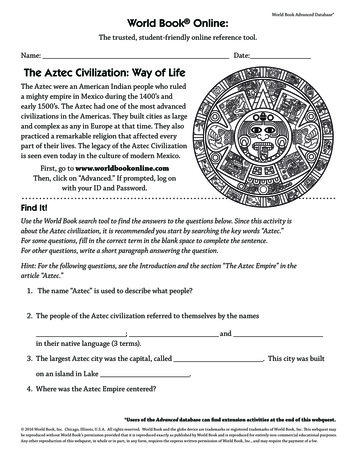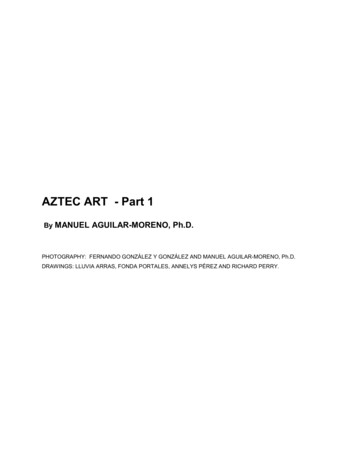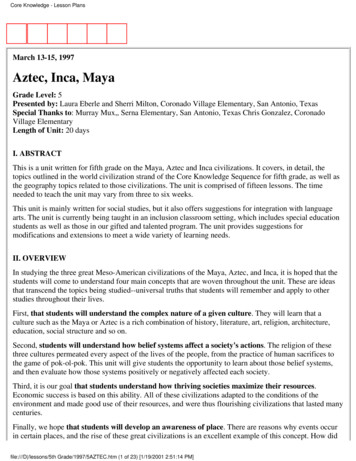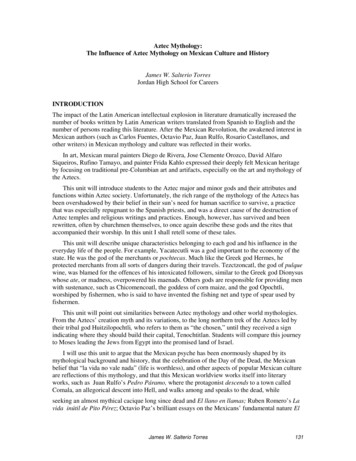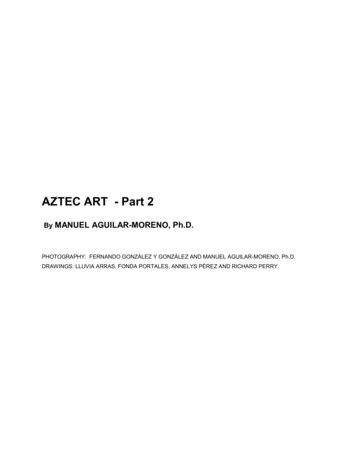
Transcription
AZTEC ART - Part 2By MANUEL AGUILAR-MORENO, Ph.D.PHOTOGRAPHY: FERNANDO GONZÁLEZ Y GONZÁLEZ AND MANUEL AGUILAR-MORENO, Ph.D.DRAWINGS: LLUVIA ARRAS, FONDA PORTALES, ANNELYS PÉREZ AND RICHARD PERRY.
TABLE OF CONTENTSINTRODUCTIONTHE AZTEC ARTISTS AND CRAFTSMENToltecaMONUMENTAL STONE edication StoneStone of the WarriorsBench ReliefTeocalli of the Sacred War (Temple Stone)The Sun StoneThe Stones of Tizoc and Motecuhzoma IPortrait of Motecuhzoma IISpiral Snail Shell (Caracol)Tlaltecuhtli (Earth God)Tlaltecuhtli del Metro (Earth God)CoatlicueCoatlicue of olxauhqui ReliefHead of CoyolxauhquiXochipilli (God of Flowers)Feathered SerpentXiuhcoatl (Fire Serpent Head)The Early Chacmool in the Tlaloc ShrineTlaloc-Chacmool
ChicomecoatlHuehueteotlCihuateotl (Deified Woman)Altar of the Planet VenusAltar of Itzpaopalotl (Obsidian Butterfly)Ahuitzotl BoxTepetlacalli (Stone Box) with Figure Drawing Blood and ZacatapayolliStone Box of Motecuhzoma IIHead of an Eagle WarriorJaguar WarriorAtlantean WarriorsFeathered CoyoteThe Acolman Cross (Colonial Period, 1550)TERRACOTTA SCULPTUREEagle WarriorMictlantecuhtliXipec TotecCERAMICSVessel with a Mask of TlalocFunerary Urn with Image of God TezcatlipocaFlutesWOOD ARTHuehuetl (Vertical Drum) of MalinalcoTeponaztli (Horizontal Drum) of FelineTeponaztli (Horizontal Drum) With Effigy of a WarriorTlalocFEATHER WORKThe Headdress of Motecuhzoma IIFeathered FanAhuitzotl ShieldChalice Cover
Christ the SaviorLAPIDARY ARTSTurquoise MaskDouble-Headed Serpent PectoralSacrificial KnifeKnife with an Image of a FaceGOLD WORKFIGURESBIBLIOGRAPHYTERRACOTTA SCULPTUREFor most cultures in Mesoamerica, terracotta sculpture was one of the principal forms ofart during the Pre-Classic and Classic periods. The Aztecs, however, were infatuatedwith the permanence of stone, and so worked less often in clay than most of theirneighbors. Except for a few larger hollow figurines, most Aztec terracotta sculptures aresmall, solid, mold-made figurines. According to Pasztory (1983), terracotta sculpturesare fundamental in identifying the cult practices and gods of the lower class Aztecs incities and remote areas. Their main subjects are the deities of nature and fertility andmothers with children; less frequently death may be the subject of a piece. Death andsacrifice seem to be the focus of noble terracotta works.Eagle WarriorThis ceramic figure was found inside of the House of Eagles, a building constructed in aNeo-Toltec style, north of the Great Temple in Mexico City [Fig. 49]. He wears an eaglehelmet, his arms are covered with wings, and his legs are adorned with claws. Someremaining stucco paint reveals that the feathers on his clothes were painted in white.Besides representing the mighty eagle warriors, this figure, along with another figurinefound in the same place, is believed to symbolize the sun at dawn. This sculpture was
on top of a multi-colored bench with the figures of warriors marching toward azacatapayolli (a ball of grass in which the blood-letting instruments were inserted). TheHouse of Eagles served as a place dedicated to prayer ceremonies, self-sacrifice, andspiritual rituals (See Section of Architecture).MictlantecuhtliThis figure was also found in the House of Eagles on top of benches, and it representsMictlantecuhtli, god of the dead [Fig. 50]. Mictlantecuhtli lived in a damp and cold placeknown as Mictlan, which was the underworld, or lower part of the cosmos--a universalwomb where human remains were kept.The god is shown wearing a loincloth and small holes in his scalp indicate that at onetime, curly human hair decorated his head, typical of earth and death god figurines. Hisclaw-like hands are poised as if ready to attack someone. Most dramatically, he isrepresented with his flesh wide-open below his chest. According to Matos and Solís(2002), out of the opened flesh in the stomach, a great liver appears, the organ wherethe ihiyotl (soul) dwells. The liver was connected to Mictlan, the Underworld. The ihiyotlis one of the three mystical elements that inhabits the human body; the tonalli, thedeterminant of one's fate, is located in the head, and the teyolia, the house ofconsciousness, resides in the heart. In this sculpture the deity is showing where one ofthose three mystical elements rests in the human body until death.Xipec TotecXipec Totec had been worshipped by the Mesoamerican people since the Classicperiod. Xipec Totec was the god of vegetation and agricultural renewal, and was one ofthe patron gods associated to the 13-day periods in the divinatory calendar [Fig. 51]. Hewas also the patron of the festival Tlacaxipehualiztli, held before the coming of the rains,in which captives were sacrificed. After the sacrificed bodies were flayed, priests worethe skins for 20 days.Xipec Totec is depicted in the sculpture as a man with a flayed skin. A rope, sculpted indetail, ties the skin at the back, head, and chest. This piece forms part of a series of
great images created by Pre-Columbian artists, who expressed their deeply held beliefthat only through death can life exist. The difference between the tight skin layer andthe animate form inside is represented in a simple manner, without the gruesomedramatization that is typical in the images of death gods and goddesses. Remarkably,the sculpture still retains its original paint; the flayed skin is yellow and the skin of XipecTotec is red.CERAMICSThe Aztecs made several functional and ceremonial objects out of clay: incenseburners, dishes, ritual vessels, funerary urns, stamps, and spindle whorls. Large vaseshaped incense burners were sometimes over 3 feet in height with a figure in high reliefon one side or an ornament of projections and flanges. Red ware goblets were oftenmade for drinking pulque at feasts. Many of these clay objects had decoration butusually without the elaborate iconographic meaning that characterized monumentalsculpture and manuscript painting.One of the most amazing works of Aztec art is a clay urn resting on three tilted cylinderlegs, found in Tlatelolco.The ceramics of the Valley of Mexico have been divided into nine different wares on thebasis of clay, type, vessel shape, surface, and decoration. Orange and red wares arethe most common. Red ware, generally associated with Tetzcoco, is usually highlyburnished and painted with a red slip; its painted designs are in black, black and white,or black, white and yellow, and they consist of simple lines and frets that often appearboldly applied. These vessels vary significantly in quality. Red ware was sometimescompletely covered with white slip, then painted with black designs of skulls andcrossed bones. In its controlled quality the line and design suggest Mixteca-Pueblavessels.Vessel with a mask of TlalocAccording to Matos and Solís (2002), this vessel was part of offering 56 at the Great
Temple of Tenochtitlan, facing north in the direction of the Temple of Tlaloc. As part ofan offering, the pot was put inside a box made out of volcanic rock containing remainsof aquatic creatures and shells, symbols of water and fertility. The box also contained asacrificial knife (tecpatl) and two bowls of copal (incense).This vessel represents the rain god Tlaloc [Fig. 52]. On the outside of the vessel, Tlalocfeatures goggle-like eyes and two fangs; a serpent surrounds his mouth forming whatlooks like a moustache. The god wears a white headdress, a reference to the mountainswhere the deity was believed to keep his waters, a place where fertility flourishes andwater flows down the hills to nourish the soil. In whole, the vessel symbolizes theuterus and the feminine powers of creation.Funerary Urn with image of god TezcatlipocaThis urn was found in the Great Temple, near the monolith of the great goddessCoyolxauhqui [Fig. 53]. Cremated bones of Aztec warriors who probably died in battleagainst the Tarascans of Michoacan during the reign of king Axayacatl were foundinside. A necklace of beads, a spear point, and a bone perforator were also inside.Inside a rectangle carved on the outside wall of the urn lies the image of Tezcatlipocasurrounded by a feathered serpent with a forked tongue. Wearing a headdress full ofeagle feathers, symbols connected to the sun, the deity seems to be armed and readyfor battle. He has a spear thrower in one hand and two spears in the other. In the handholding the two spears he wears a protector similar to the ones used in Toltec imagery.He wears a smoking mirror, his characteristic symbol, on one of his feet.According to Matos and Solis (2002), this urn represents one of those warriors thatembodies the image of the god Tezcatlipoca (smoking mirror), a creator god thatinhabits the four horizontal directions and the three vertical levels of the cosmos.Tezcatlipoca is also the protector of warriors, kings, and sorcerers and the god of thecold who symbolized the dark night sky. He was considered invisible and mysterious.FlutesIn Aztec festivities, clay flutes were commonly played. The shape and decoration of
these instruments varied according to the gods being worshipped at the time [Fig. 54].According to Matos and Solís (2002), at the feast of Toxcatl, the person chosen topersonify the god Tezcatlipoca played a sad melody with a thin flute with a flower shapeat the end while walking up to the temple to be sacrificed. Depending on the occasion,the Aztecs made flutes with different shapes, such as the image of the god HuehueteotlXiuhtecuhtli. The god is shown as an old man with a beard symbolizing wisdom.Another flute ends with the shape of an eagle, a symbol of divine fire, the sun, andwarriors. The eagle seems to be wearing a headdress. Some flutes have elegantornaments, like the step-fret design used in Aztec-Mixtec gold rings. This flute showsthe blending of the Aztec and Mixtec cultures, and suggests that besides wars, therewas trade and exchange of cultural traditions.WOOD ARTWood was not just a substitute for stone. Many of the icons, or idols, in the major Aztectemples were made out of wood and dressed in beautiful clothes and jewelry. However,the symbolic significance of wood for the Aztecs is unclear. Many Aztec texts refer tothe superiority of stone figures to wooden ones because of their durability andendurance. But, in weight, flexibility, and resonance, wood was the perfect material forsuch objects as drums, spear-throwers, shields, and masks. Some objects were alsomade of wood so that they could be burned symbolically as offerings.Huehuetl (Vertical Drum) of MalinalcoIn the town of Malinalco, it was found a wooden tlalpanhuehuetl or war drum, still usedin some ceremonies until 1894, when it was transferred to its present location in theMuseum of the City of Toluca [Fig. 55]. The Huehuetl contains the date Nahui-Ollin (4Movement). The Ollin symbol was used to represent the movement of the Sun and thedynamic life of the World. From the word ollin derives yollotl (heart) and yoliztli (life).Inside of this particular Ollin we find a ray emanating from a solar eye and a chalchihuitl(precious stone). The Sun was considered as the “Shining One”, the “Precious Child”,the “Jade” and “Xiuhpiltontli” (Turquoise Child). The date nahui-ollin alludes to OllinTonatiuh, the Sun of Movement, the present world that will be destroyed by
earthquakes, and to the festival of Nahui-Ollin, described by Durán (1967), in which themessenger of the Sun was sacrificed.To the right of the date Nahui-Ollin, the artist carved the outstanding figure of an ocelotl(jaguar) and to the left a cuauhtli (eagle), both dancing. These images representcuauhtli and ocelotl warriors, distinguished orders of the Aztec army. These warriorscarry the flag of sacrifice (pámitl) and wear a headdress with heron feathers (aztaxelli),a symbol of hierarchy.In the lower sections that support the Huehuetl, there are two more ocelotl warriors andone cuauhtli warrior. From the mouths and beaks of the warriors and around their pawsand claws, appears the glyph Atl-Tlachinolli, or Teuatl-Tlachinolli, that means “divinewater (blood)-fire”; it signals the call of war and is sometimes represented as a songand dance of war. This metaphor Atl-Tlachinolli is expressed in sculpture, carvings, andthe codices as two intertwined rivers, one of water and the other of fire. The stream ofwater ends with pearls and conches, while the stream of fire ends with the body of thexiuhcoatl (snake of fire) who is emitting a flame.All the warriors depicted on the Huehuetl have in one of their eyes the sign atl (water),which indicates that they are crying while they sing. This sign reveals the duality offeelings before the sacrifice. One of the ocelotl warriors has behind one of his paws thesign atl combined with an aztamecatl (rope), indicating that he is a Uauantin (captivestriped in red) who will be sacrificed in the temalácatl. This recalls the image of awarrior carrying a rope in the mural of Temple III of the site. The cuauhtli warriors havehanging among their feathers obsidian knifes (tecpatl), symbols of human sacrifice.A band divides the two parts of the Huehuetl and portrays chimallis (shields) withbundles of cotton and arrows (tlacochtli), sacrificial flags (pamitl) and a continuousstream of the glyph Atl-Tlachinolli. All of these are metaphors of war. Interestingly, theHuehuetl represents a real event in Malinalco: the scene of cuauhtli-ocelotl warriorssinging, dancing and crying in the festival of Nahui-Ollin, that ended with the dance ofthe messenger of the Sun who, ascending the staircase to reach the doorway of the
Cuauhcalli, would be sacrificed and his heart and blood would be placed in thecuauhxicalli that stood behind the eagle-shaped image of the Sun (See Malinalco’sTemples in Section of architecture).The Sun is called when is in ascensionCuauhtehuanitl (Rising Sun) and in the afternoon when it is descending is calledCuauhtemoc (Setting Sun).The Sun was considered as the young warrior that every day at dawn, fight in theheavens to defeat the darkness, stars and moon (metztli), using as weapons thexiuhcoatls (snakes of fire, solar rays). In this way he ascends to the zenith, preceded byTlahuizcalpantecuhtli, the morning star (Venus).At dusk, the Sun, preceded by Xolotl, the evening star (Venus) sets in Tlillan Tlapallan,the Land of the Black and Red, and descends to the underground transformed into ajaguar to illuminate the world of the dead. The next dawn, in an endless cycle, he willrepeat his cosmic fight to bring a new day to humankind.The Huehuetl of Malinalco presents the image of Cuauhtehuanitl, Tonatiuh in his eagleembodiment (Huitzilopochtli), ascending to the zenith in the sky [Fig. 56]. The face ofthe god is emerging from the beak of the eagle and has a turquoise (yacaxihuitl) in hisnose. Under his chin appears the sign of singing, cuicatl, which indicates that the deityascends singing. The feathers of the eagle are stylized in a way that resembles theprecious feathers of the quetzal.The ascending Sun (Cuauhtehuanitl) is accompanied by the xiuhcoatls (snakes of fire)who carry him during his daily cycle. They are also the embodiments of the solar rays.We can see the representation of the heads of the xiuhcoatls featuring open mouth withfangs, solar eye and a horn. One of them has a realistic shape, while the other isportrayed with more abstraction, but shows the same characteristic elements.The quality of the Aztec sculpture and carving applied to this Huehuetl is so precise andrefined that it is comparable to the amazing and powerful expression of the codices. Theimages shown by this musical masterwork confirm and complement our hypothesisabout the function and uses of the “Cuauhtinchan” (Temple I) of Malinalco.
Teponaztli (Horizontal Drum) of a FelineThe teponaztli, a horizontal type of drum still in use today, was another popularinstrument used by the Aztecs [Fig. 57]. The drum is a double-tongued xylophone. Thetongues are made out of slits positioned in a hollowed piece of wood that works as thesound box. Hammers in the shape of sticks with rubber tips were used to hit thetongues, thereby producing the tones and melodies of the drum. A teponaztli fromMalinalco is in the National Museum of Anthropology in Mexico City. After the Spanishconquest, the missionaries prohibited traditional Mexica ritual practices and they oftendestroyed artifacts belonging to those rituals; it is fortunate that this teponaztli survives.The animal carved on this horizontal drum is either a crouching coyote or a type ofjaguar with its tail next to its left side. It could represent the nahual (soul or double) of acoyotl or a jaguar warrior. However, the curls on the head of the animal have led somescholars to identify it as an ahuitzotl, or a water-thorn beast, possibly a water possum.Amazingly, this horizontal drum still has the original canine teeth and molars placedinside the mouth to make the animal look more realistic and ferocious.Teponaztli (Horizontal Drum) with Effigy of a WarriorThe human effigy depicted on this teponaztli is a representation of a reclining Tlaxcalanwarrior [Fig. 58]. Matos and Solís (2002) point out that the representation of this warrioris decorated with the unique military emblems of his Tlaxcalan culture. His weaponsinclude the jaw of a sawfish and an axe with a copper blade. The eyes of the warriorstill preserve their shell and obsidian inlays.TlalocThis wood sculpture is an example of a work meant to be burned in honor of Tlaloc.Such figures were made out of resin and copal applied to sticks and burnt after a prayerwas offered Tlaloc. The Aztecs believed that the smoke rising from the burning resinand copal would make the clouds dark and cause them to liberate a fertilizing rain overthe earth. This image was found inside a cave in Iztaccihuatl volcano.
This sculpture features the characteristics consistently attributed to the rain god Tlaloc:ear ornaments, goggle-like eyes, protruding fangs, and a headdress symbolizing themountains where he kept water.This sculpture also features a folded paper bowbehind Tlaloc’s neck, which, according to Matos and Solís (2002), represents thetlaquechpanyotl, the sign of the deity’s noble ancestry.FEATHER WORKAmong the large variety of media utilized by the Aztec craftsmen/artists, their featherwork is perhaps the least known today. The Aztecs became master feather-craftersbefore the arrival of the Spaniards, and had developed highly sophisticated methods ofgathering feathers throughout their territories and incorporating them into objects ofimpressive visual impact and surprising durability. The artists in the village of Amatlan(a district of Tenochitlan) were exceptionally known for their feather work.The amanteca (feather-workers) either fixed their precious tropical feathers on light reedframeworks by tying each one onto the backing with cotton, or fastened them on cloth orpaper to form mosaics in which certain effects of color were obtained by exploiting theirtransparent qualities. Belonging exclusively to the Aztecs, this art lingered in the form oflittle feather icons after the Conquest and then almost disappeared entirely.Only a handful of these original masterpieces have survived, and today there are only ahandful of artists scattered in diverse cities of Mexico who keep the art of feather-workalive. While the Spanish did not consider feather-works to be as valuable as gold orprecious stones, nor a treasure worth preserving, they sent shiploads of it to Spain ascuriosities from the New World. The many churches, monasteries, and individuals whoreceived these precious gifts did not protect them from the natural process of decay,and out of hundreds of costumes, mantles, standards, and shields sent to Europe, todayonly a few pieces are known to exist. There are some surviving examples, such asChristian symbols, made in colonial times in a style similar to that of the Renaissance,that constitute the best of feather-work.
Pasztory (1983) affirms that colorful tropical birds such as the scarlet macaw, variousspecies of parrot, red spoonbill, blue cotinga, and the quetzal provided most of thevibrant feathers used in mosaic feather-work. The most common colors used were redand yellow. The most precious colors used were blue and green, the colors of water andagriculture, fertility and creation. Green quetzal feathers were among the rarest andmost sought after; in Nahuatl, quetzal meant precious. The two long green tail feathersof the male quetzal birds were collected for great headdresses and standards.Unfortunately, the precious bird quetzal is today an endangered species. Almost asprecious as the quetzal were hummingbird feathers; often greenish in color,hummingbird feathers become iridescent when lit from certain angles.As pointed out by Castelló Iturbide (1993), together with stones such as jade andturquoise, feathers were considered among the most valued objects of Mesoamerica.They were so highly venerated that statues of Aztecs deities were clothed in cloaks fullof brilliant feathers and precious stones.Viewed in magical terms, feathers wereconsidered icons of fertility, abundance, and wealth and power, and they connected theindividual or statue wearing them with the divine. According to Fray Diego Durán (1967),the Aztecs believed that the feathers were shadows of the deities.The Headdress of Motecuhzoma IIAssembled from five hundred quetzal feathers taken from 250 birds, this featherheaddress is one of the best examples that have survived over time [Fig. 59]. Despiteits name, it is still unclear if it was used or it belonged to this emperor. According toPasztory (1983), a model of a crown used by Motecuhzoma was depicted in the CodexMendoza, and it was composed of turquoise, not feathers. The headdress probablyderives its name from this traditional story: when Motecuhzoma met Cortés, he gave theConquistador luxurious items that included headdresses, gold and silver objects,clothes, among many other things, in a diplomatic gesture to please and salute EmperorCharles V.When the brother of Charles V, Ferdinand, married, he received theHeaddress of Motecuhzoma II that had been stored in the Ambras Castle in Tyrol,
Austria. In time, the art collections of the Habsburg Monarchy were placed in statemuseums, and now the famous headdress is housed in the Museum of Ethnology inVienna, together with a feathered fan and the Ahuitzotl Shield. There is a replica of theheaddress in the National Museum of Anthropology of Mexico City [Fig. 60].This kind of feather headdress was probably used as a military insignia instead of acrown. The feather headdress would have been placed on a bamboo stick andpositioned on a distinguished soldier’s back. Pasztory (1983) has suggested that thereis evidence that headdresses, such as this piece, were part of the Aztec royalty forritualistic purposes, especially to be worn when impersonating the god Quetzalcoatl.Feathered FanIn pre-Conquest periods, fans were a symbol of noble and pochteca (professionaltraders) classes. According to Matos and Solís (2002), fans gave a fancy touch to thewardrobes of the tlatoani (Emperor) and his royal family, who always looked elegantand distinguished.The fans were eye-catching pieces constructed of wood anddecorated with colorful feathers.A fan found north of the Tlaloc Temple, in a place considered to be part of the sacredprecinct of the Aztec capital, was restored by a professional feather-worker and is keptin the National Museum of Anthropology of Mexico City. The tip of the fan depicts thehead of a warrior who is well dressed for war. Another beautiful example of a preservedfan can be found in the Museum of Ethnology of Vienna [Fig. 62].Ahuitzotl ShieldThe Chimalli (shield) of Ahuitzotl was a gift from Hernán Cortés to Don Pedro de laGasca, Bishop of Palencia, Spain. It is an assemblage of different types of feathers,including feathers from scarlet macaws, blue cotingas, rose spoonbills, and yelloworioles; tassels of feathers hang from the lower edge [Fig. 63]. Vegetable fibers holdtogether the base of reed splints that supports the colorfully arranged plumage. On theback, two loops are formed to allow the shield to be carried.The Ahuitzotl Shield portrays the figure of a Coyotl warrior in gold and feathers. The
symbol of the sacred war atl-tlachinolli (the water, the fire) comes out of his mouth,indicating that he is shouting a call or song of war. The figure depicted on the shield isnot an ahuitzotl (fantastical water being) as has been traditionally identified. Watercreatures are linked to the rain god Tlaloc. Rather, the animal represented may be acoyote associated to warfare and a military Aztec order.The Ahuitzotl Shield is housed in the Museum of Ethnology in Vienna, along with theHeaddress of Motecuhzoma II and a feathered fan.Chalice CoverThis object, found by Rafael García Granados, comes from the early transitional timesof the campaign to convert all of the Mesoamerican indigenous populations toCatholicism [Fig. 64]. The blue creature adorning the cover may be related to the godTlaloc, since it has goggle-like eyes and a moustache. If this is true, the cover may beassociated with one of the most sacred liquids of the universe—water. According toMatos and Solís (2002), the circular panel surrounding the creature in the centerrepresents water in motion, and in terms of Christian doctrine, symbolizes the holywater communicating the message of God. God is shown as a stylized Aztec Tlalocmask with fangs, which throws fire out of His mouth. In the context of Christianity, thefire represents the blood of the sacrificed Christ that cleanses the world of human sin; atthe same time, the fire is an indigenous symbol of the primeval waters of the old Aztecdeities. This piece expresses the complex process of transculturation that occurredthduring the 16 century in Mexico while two different cultures tried to establish a religiousdialogue.Christ the SaviorAfter the Spanish conquest, feather-art was applied to ritual objects with the shape andiconography of the new religion.One example is an embodiment of Christ the Savior,who blesses the World with his right hand. The orb that he is holds in his left hand is anicon of sovereignty, which was considered, during the Middle Ages, an emblem of divinepower. An inscription surrounds the image of Christ, but it has not yet been translatedsuccessfully.
LAPIDARY ARTSThe Aztecs had a very special interest in precious stones of all kinds. Since their culturewas primarily Neolithic (New Stone Age), tools were predominantly made of stone,though copper tools were also utilized. Obsidian and flint were used to make the rituallyvalued sacrificial knives; obsidian also served as scraping and more domestic cuttingimplements.The Mexica were particularly skilled at carving hard stones of different colors andbrilliant surfaces, such as greenstone, porphyry, obsidian, rock crystal, turquoise, andonyx. From these stones, they created a variety of sculptures, vessels, and jewelry. Inthe lapidary art, the Aztecs made elaborate art pieces of rock-crystal, amethyst, jade,turquoise, obsidian, and other important stones, as well as mother of pearl. Usinginstruments of reed, sand, and emery, they arranged small pieces of stone in brilliantmosaics on backgrounds of bone, stucco, and wood.It was a sign of status for the men of the highest class to learn the lapidary arts. Theirtechnique was called toltecayotl (the matter of the Toltecs, or the Toltec thing) and wasbased on the Toltec artistic traditions that the Aztecs so admired.The green stones, such as jadeite, diorite, and serpentine, were the most importantprecious stones in Mesoamerica. Jade beads were placed on a corpse’s mouth aspayment for the trip of the soul of the dead person through the Underworld, a traditionalso found in ancient China. The greenstone acted as an offering to protect the soul inits journey through the afterlife.Greenstones were also buried in the floor of thetemples. Green was a symbol for water and plants, life and fertility.The wordchalchihuitl (jade symbol) was an embodiment of preciousness.Greenstone, such as jade, came from the province of Guerrero and was offered astribute by the southern provinces. The most famous lapidary artists in the Valley ofMexico were the artisans of Chalco and Xochimilco; the lapidary art was said to comefrom the artisans of Xochimilco.
Turquoise MaskThis beautiful blue mask is believed to represent Xiuhtecuhtli, the god of fire [Fig. 66].Matos and Solís (2002) state that the deity’s name Xiuhtecuhtli (Turquoise Lord) is aderivative of the Nahuatl word for year (xihuitl), which makes him a deity of time. Theturquoise pieces are affixed to a cedar wood base with a kind of resinous substance.Made out of pearl oyster shell, the eyes have a central hole suggesting thatimpersonators of divine beings in religious rituals wore the mask. His teeth are alsomade out of shells. This mask is one of the best surviving examples of its kind from thePost Classic period.Double-Headed Serpent PectoralThis pectoral features double-headed and intertwined serpents associated with thefeathered serpent god, Quetzalcoatl. Their jaws are open, symbolizing the caves ofMictlan, gateways to the underworld. The whole piece is a wooden base covered withturquoise mosaic inlays making it look as blue as the sky. The noses, gums, and teethof the reptiles are inlaid with white and red shells.Double headed and intertwined serpents were icons in Mesoamerican art thatrepresented the sky [Fig. 67]. The serpents were a symbol of renewal since they shedtheir skin. They are also metaphoric streams of blood. In this context, the pectoral is awork dedicated to life, which depends on death and the Underworld in order to renewitself.It is believed that a priest
Eagle Warrior This ceramic figure was found inside of the House of Eagles, a building constructed in a Neo-Toltec style, north of the Great Temple in Mexico City [Fig. 49]. . House of Eagles served as a place dedicated to prayer ceremonies, self-sacrifice, and spiritual rituals (See Section of Architecture).
